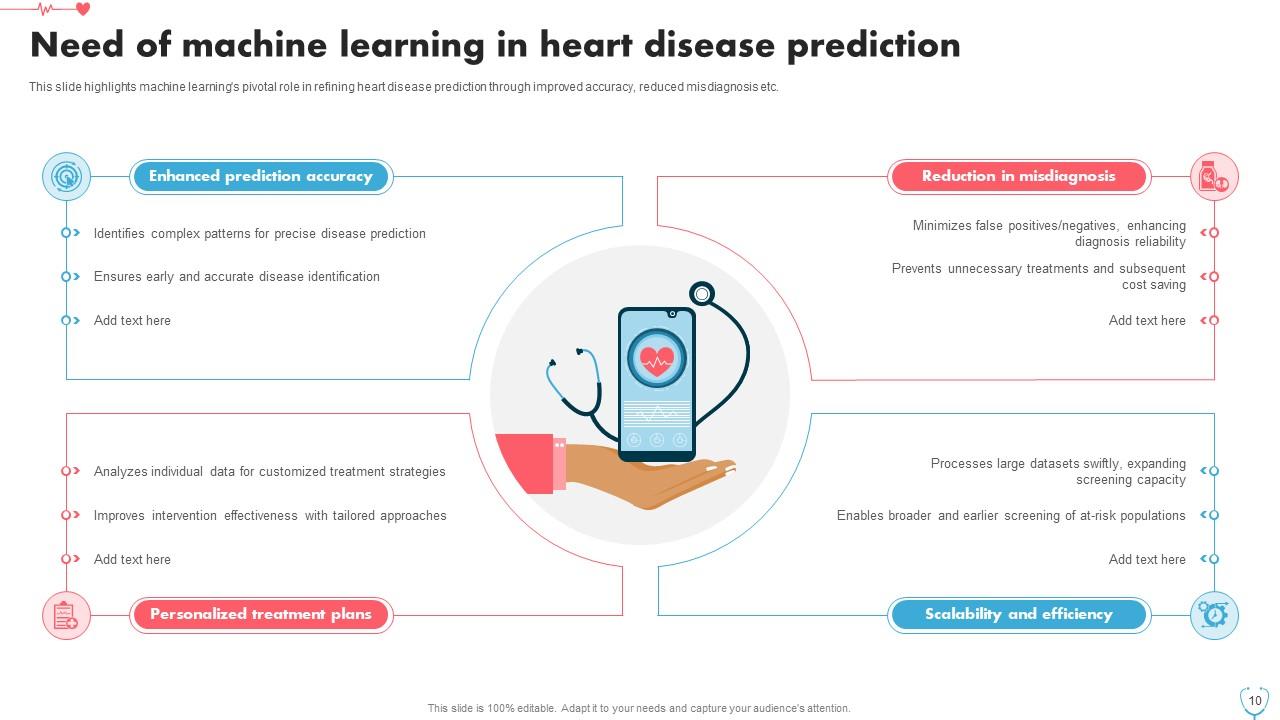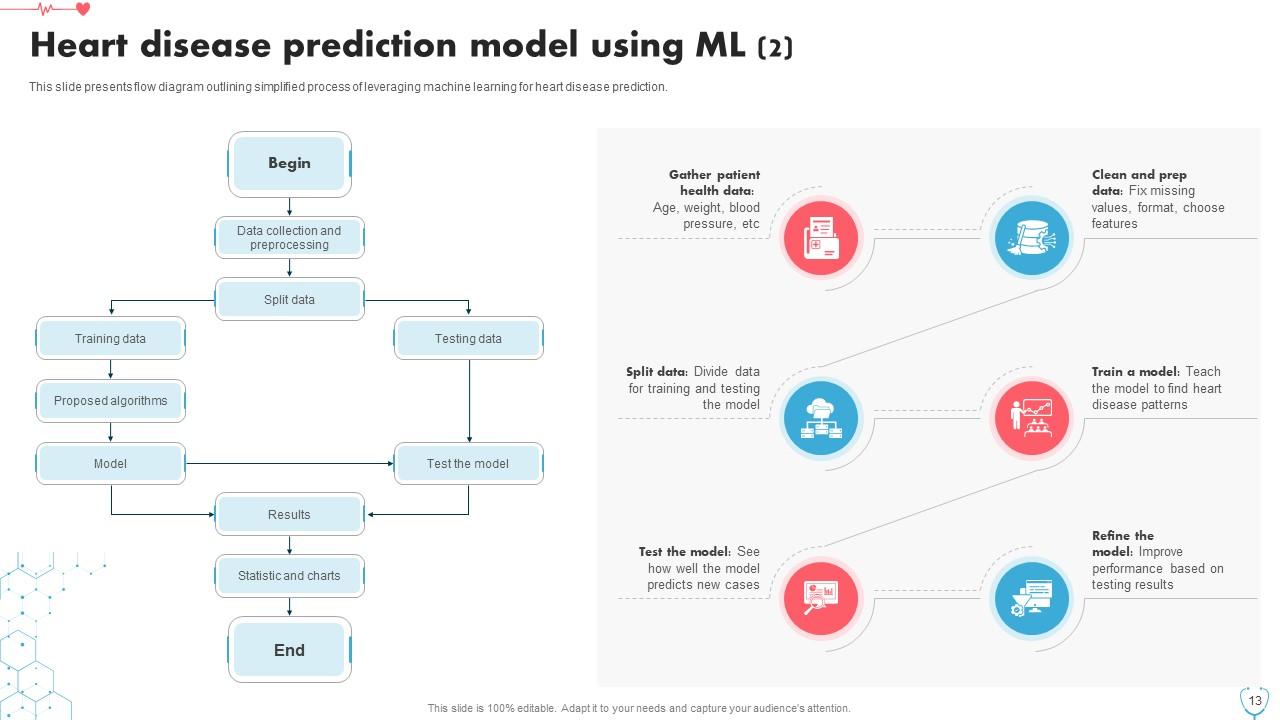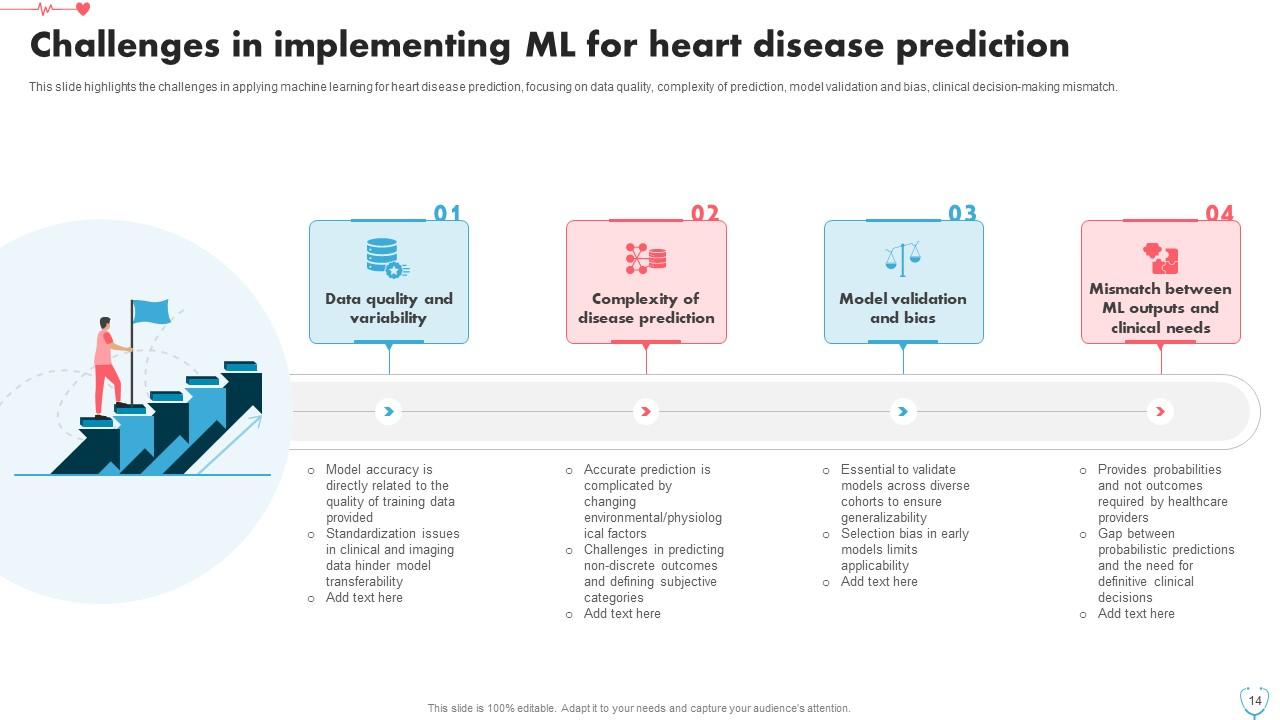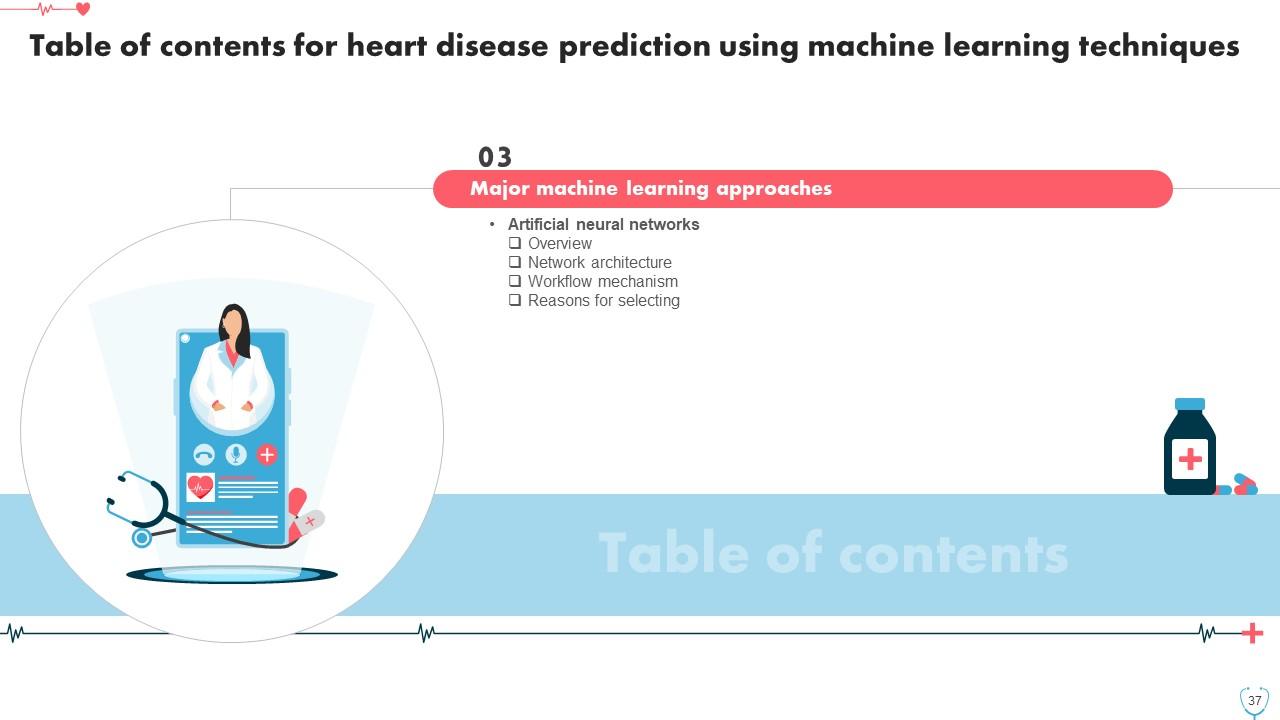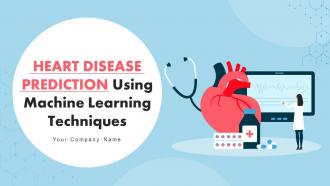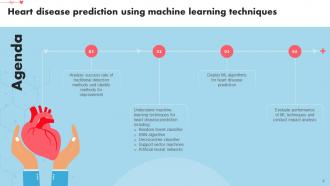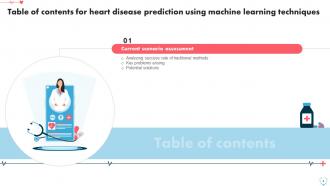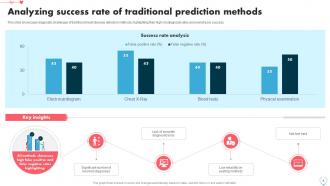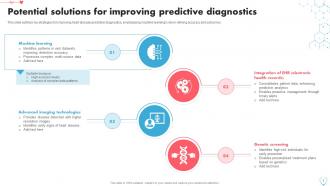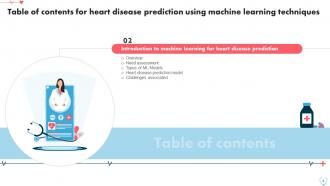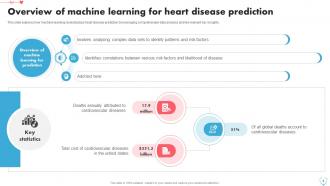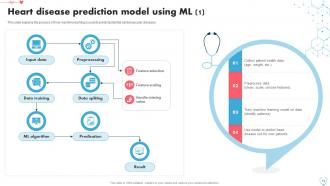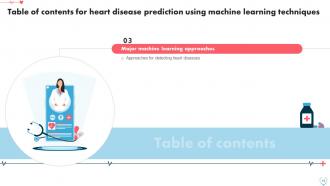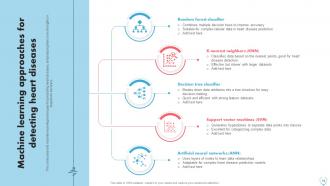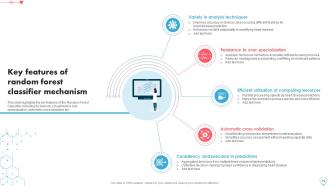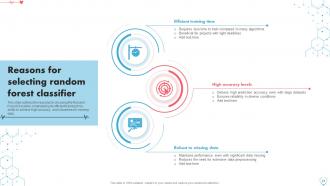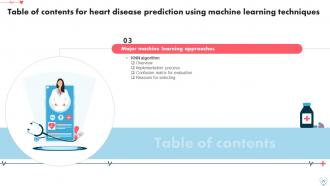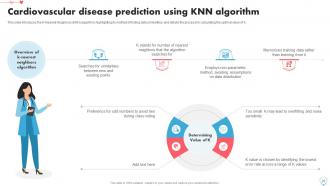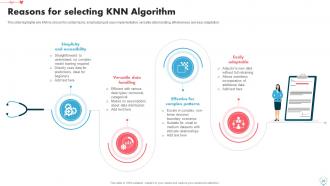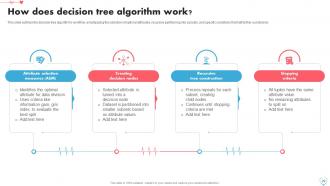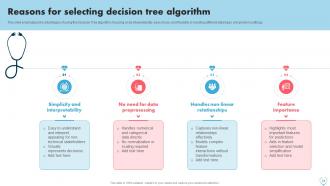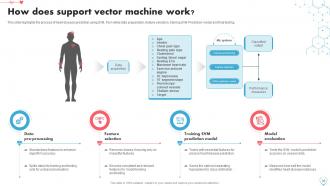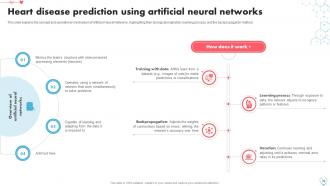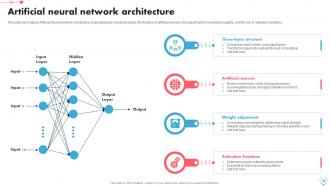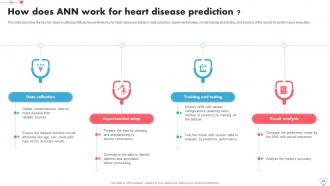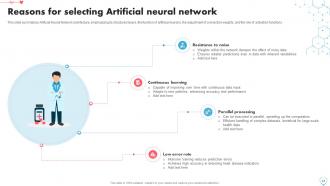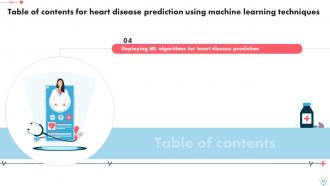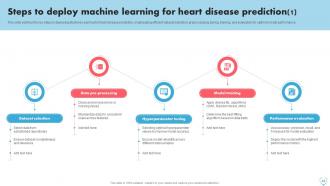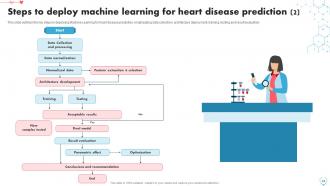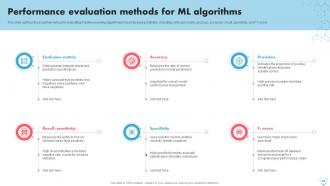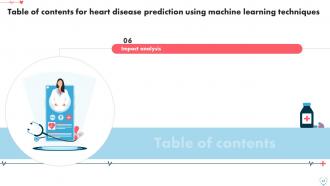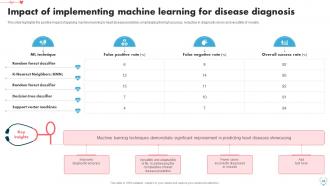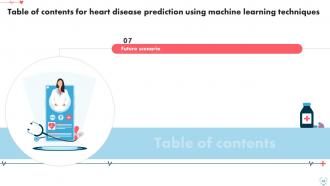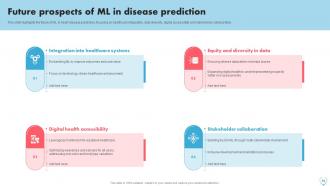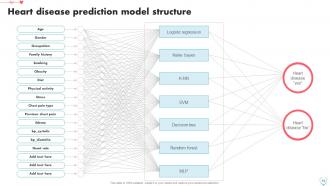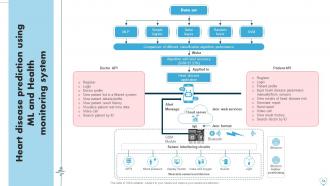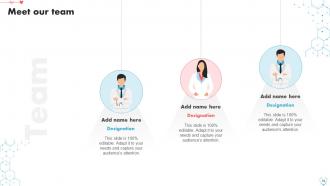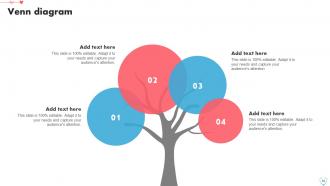Heart Disease Prediction Using Machine Learning Techniques ML CD
Discover the future of healthcare with our professionally made Heart Disease Prediction Using Machine Learning Techniques PowerPoint presentation. This PPT Bundle starts with an overview of how Machine Learning ML is changing the early detection and management of heart disease. The presentation explores multiple ML techniques, including a Random Forest Classifier, a KNN Algorithm, a Decision Tree Classifier, a Support Vector Machine, and Artificial Neural Networks ANN. These techniques offer key relevant insights into predictive accuracy and efficiency. Moreover, the Machine Learning PPT slides present a step-by-step process of deploying ML models for heart disease prediction, from data collection to model training and evaluation. It provides a detailed analysis of each models performance, evaluating them on metrics like accuracy, precision, recall, and F1-score to highlight their impact in healthcare scenarios. Furthermore, the Deep Learning PPT slides discuss the broader implications of ML in healthcare, picturing a future where technology enhances patient outcomes and promotes equitable access to care. Download our 100 percent editable and customizable PowerPoint, compatible with Google Slides, to streamline your presentation process.
- Google Slides is a new FREE Presentation software from Google.
- All our content is 100% compatible with Google Slides.
- Just download our designs, and upload them to Google Slides and they will work automatically.
- Amaze your audience with SlideTeam and Google Slides.
-
Want Changes to This PPT Slide? Check out our Presentation Design Services
- WideScreen Aspect ratio is becoming a very popular format. When you download this product, the downloaded ZIP will contain this product in both standard and widescreen format.
-

- Some older products that we have may only be in standard format, but they can easily be converted to widescreen.
- To do this, please open the SlideTeam product in Powerpoint, and go to
- Design ( On the top bar) -> Page Setup -> and select "On-screen Show (16:9)” in the drop down for "Slides Sized for".
- The slide or theme will change to widescreen, and all graphics will adjust automatically. You can similarly convert our content to any other desired screen aspect ratio.
Compatible With Google Slides

Get This In WideScreen
You must be logged in to download this presentation.
PowerPoint presentation slides
Deliver an informational PPT on various topics by using this Heart Disease Prediction Using Machine Learning Techniques ML CD. This deck focuses and implements best industry practices, thus providing a birds-eye view of the topic. Encompassed with sixty two slides, designed using high-quality visuals and graphics, this deck is a complete package to use and download. All the slides offered in this deck are subjective to innumerable alterations, thus making you a pro at delivering and educating. You can modify the color of the graphics, background, or anything else as per your needs and requirements. It suits every business vertical because of its adaptable layout.
People who downloaded this PowerPoint presentation also viewed the following :
Content of this Powerpoint Presentation
Slide 1: This slide introduces Heart Disease Prediction Using Machine Learning Techniques. State your company name and begin.
Slide 2: This is an Agenda slide. State your agendas here.
Slide 3: This slide shows Table of Content for the presentation.
Slide 4: This slide shows title for topics that are to be covered next in the template.
Slide 5: This slide showcases diagnostic challenges of traditional heart disease detection methods, highlighting their high misdiagnosis rates and overall poor success.
Slide 6: This slide outlines the major repercussions of inadequate heart disease diagnostics including reduced patient trust, strained healthcare resources, negative outcomes etc.
Slide 7: This slide presents key strategies for improving heart disease predictive diagnostics, emphasizing machine learning's role in refining accuracy and outcomes.
Slide 8: This slide shows title for topics that are to be covered next in the template.
Slide 9: This slide explores how machine learning revolutionizes heart disease prediction by leveraging comprehensive data analysis and few relevant key insights.
Slide 10: This slide highlights machine learning's pivotal role in refining heart disease prediction through improved accuracy, reduced misdiagnosis etc.
Slide 11: This slide succinctly outlines the roles of supervised, unsupervised, and reinforcement learning in heart disease prediction and emphasizes their capabilities.
Slide 12: This slide explains the process of how machine learning is used to predict potential cardiovascular diseases.
Slide 13: This slide presents flow diagram outlining simplified process of leveraging machine learning for heart disease prediction.
Slide 14: This slide highlights the challenges in applying machine learning for heart disease prediction, focusing on data quality, complexity of prediction etc.
Slide 15: This slide shows title for topics that are to be covered next in the template.
Slide 16: This slide presents machine learning techniques for predicting heart diseases, emphasizing their core strengths in diagnostic accuracy.
Slide 17: This slide shows title for topics that are to be covered next in the template.
Slide 18: This slide highlights the approach of random forest classifier for heart disease prediction and its relevant key features.
Slide 19: This slide highlights the key features of the Random Forest Classifier, including its diversity, robustness to over specialization, automatic cross validation etc.
Slide 20: This slide outlines the random forest classifier's workflow, highlighting the steps from sampling and tree construction to prediction aggregation.
Slide 21: This slide outlines the reasons for choosing the Random Forest Classifier, emphasizing its efficient training time, ability to achieve high accuracy, and robustness to missing data.
Slide 22: This slide shows title for topics that are to be covered next in the template.
Slide 23: This slide introduces the K-Nearest Neighbors (KNN) algorithm, highlighting its method of finding data similarities, and details the process for calculating the optimal value of K.
Slide 24: This slide presents a concise guide to applying K-Nearest Neighbor for heart disease prediction, from initial data setup to final performance evaluation etc.
Slide 25: This slide showcases confusion matrix to evaluate the results obtained from KNN algorithm model as per their corresponding rating obtained.
Slide 26: This slide highlights why KNN is chosen for certain tasks, emphasizing its easy implementation, versatile data handling, effectiveness and easy adaptation.
Slide 27: This slide shows title for topics that are to be covered next in the template.
Slide 28: This slide introduces the decision tree model for cardiovascular disease prediction, highlighting its foundation in supervised learning.
Slide 29: This slide outlines the decision tree algorithm's workflow, emphasizing the selection of optimal attributes, recursive partitioning into subsets etc.
Slide 30: This slide explains the concepts of Information Gain, Gain Ratio, and Gini Index, highlighting their role in optimizing decision tree splits by evaluating attribute purity and split quality.
Slide 31: This slide emphasizes the advantages of using the Decision Tree algorithm, focusing on its interpretability, ease of use, and flexibility in handling different data types.
Slide 32: This slide shows title for topics that are to be covered next in the template.
Slide 33: This slide introduces the support vector machine model for cardiovascular disease prediction, highlighting its key features of liner/non liner classification and data handling.
Slide 34: This slide breaks down key SVM terminologies, highlighting the roles of hyperplanes, support vectors, and margins in constructing effective classification boundaries
Slide 35: This slide highlights the process of heart disease prediction using SVM, from initial data preparation, feature selection, training SVM Prediction model and final testing.
Slide 36: This slide highlights the reasons for selecting SVM, focusing on its efficiency in high-dimensional spaces, effectiveness with small datasets etc.
Slide 37: This slide shows title for topics that are to be covered next in the template.
Slide 38: This slide explains the concept and operational mechanism of Artificial Neural Networks, highlighting their biological inspiration, learning process, and the backpropagation method.
Slide 39: This slide summarizes Artificial Neural Network architecture, emphasizing its structured layers, the function of artificial neurons, the adjustment of connection weights etc.
Slide 40: This slide describes the four key steps in utilizing Artificial Neural Networks for heart disease prediction: data collection, experimental setup, model training and testing etc.
Slide 41: This slide summarizes Artificial Neural Network architecture, emphasizing its structured layers, the function of artificial neurons, the adjustment of connection weights etc.
Slide 42: This slide shows title for topics that are to be covered next in the template.
Slide 43: This slide outlines the key steps in deploying Machine Learning for heart disease prediction, emphasizing efficient dataset selection, preprocessing, tuning etc.
Slide 44: This slide outlines the key steps in deploying Machine Learning for heart disease prediction, emphasizing data collection, architecture deployment, training, testing etc.
Slide 45: This slide shows title for topics that are to be covered next in the template.
Slide 46: This slide outlines the essential metrics for evaluating machine learning algorithms in heart disease prediction, including confusion matrix, accuracy, precision etc.
Slide 47: This slide shows title for topics that are to be covered next in the template.
Slide 48: This slide highlights the positive impact of applying machine learning to heart disease prediction, emphasizing the high accuracy, reduction in diagnostic errors and versatility of models.
Slide 49: This slide shows title for topics that are to be covered next in the template.
Slide 50: This slide highlights the future of ML in heart disease prediction, focusing on healthcare integration, data diversity, digital accessibility and stakeholder collaboration.
Slide 51: This slide shows all the icons included in the presentation.
Slide 52: This slide is titled as Additional Slides for moving forward.
Slide 53: This slide displays Heart disease prediction model structure.
Slide 54: This slide presents Heart disease prediction using ML and Health monitoring system.
Slide 55: This slide displays IoT Cloud based heart disease prediction via machine learning.
Slide 56: This is Our Vision, Mission & Goal slide. Post your Visions, Missions, and Goals here.
Slide 57: This is About Us slide to show company specifications etc.
Slide 58: This is Our Team slide with names and designation.
Slide 59: This is a financial slide. Show your finance related stuff here.
Slide 60: This slide depicts Venn diagram with text boxes.
Slide 61: This is a Timeline slide. Show data related to time intervals here.
Slide 62: This is a Thank You slide with address, contact numbers and email address.
Heart Disease Prediction Using Machine Learning Techniques ML CD with all 71 slides:
Use our Heart Disease Prediction Using Machine Learning Techniques ML CD to effectively help you save your valuable time. They are readymade to fit into any presentation structure.
-
“The presentation template I got from you was a very useful one.My presentation went very well and the comments were positive.Thank you for the support. Kudos to the team!”
-
Unique and attractive product design.











